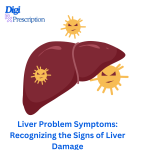
Recognizing the symptoms of liver problems early can help in seeking timely medical intervention and preventing further damage. Here are some common symptoms of liver problems to watch out for:
1. Jaundice
What it is: Yellowing of the skin and eyes.
Why it happens: Jaundice occurs when the liver cannot properly process bilirubin, a yellow pigment formed by the breakdown of red blood cells.
What to look for: Yellow tint in the skin, eyes, and mucous membranes.
2. Fatigue and Weakness
What it is: Persistent tiredness and lack of energy.
Why it happens: A damaged liver struggles to remove toxins from the blood, leading to a buildup that can cause fatigue.
What to look for: Feeling exhausted even after adequate rest.
3. Abdominal Pain and Swelling
What it is: Pain or discomfort in the upper right side of the abdomen.
Why it happens: Liver inflammation or enlargement (hepatomegaly) can cause pain and swelling in the abdominal area.
What to look for: Bloating, tenderness, or a feeling of fullness in the abdomen.
4. Dark Urine
What it is: Urine that is darker than usual, often brownish or amber-colored.
Why it happens: Elevated bilirubin levels due to liver dysfunction can cause dark urine.
What to look for: Changes in urine color, especially if accompanied by pale stools.
5. Pale or Clay-Colored Stools
What it is: Stools that are lighter in color than normal.
Why it happens: Liver problems can reduce bile production, leading to pale stools.
What to look for: Stools that are white, gray, or clay-colored.
6. Nausea and Vomiting
What it is: Persistent nausea or vomiting.
Why it happens: A compromised liver can lead to digestive issues, including nausea and vomiting.
What to look for: Frequent feelings of nausea, especially after eating.
7. Loss of Appetite
What it is: Reduced desire to eat.
Why it happens: Liver dysfunction can affect digestion and metabolism, leading to a loss of appetite.
What to look for: Sudden or unexplained weight loss.
8. Swelling in the Legs and Ankles (Edema)
What it is: Fluid retention in the lower extremities.
Why it happens: Liver damage can lead to poor blood flow and fluid buildup in the legs and ankles.
What to look for: Swelling, puffiness, or discomfort in the legs.
9. Itchy Skin
What it is: Persistent itching without a rash.
Why it happens: A buildup of bile salts under the skin due to liver dysfunction can cause itching.
What to look for: Itching that worsens at night or doesn’t respond to usual treatments.
10. Easy Bruising and Bleeding
What it is: Bruising or bleeding more easily than usual.
Why it happens: The liver produces proteins necessary for blood clotting. When it’s damaged, clotting is impaired.
What to look for: Frequent nosebleeds, bleeding gums, or unexplained bruises.
11. Confusion or Cognitive Issues (Hepatic Encephalopathy)
What it is: Mental confusion, memory problems, or difficulty concentrating.
Why it happens: Toxins that the liver cannot filter may affect brain function.
What to look for: Forgetfulness, disorientation, or changes in behavior.
12. Spider Angiomas
What it is: Small, spider-like blood vessels visible under the skin.
Why it happens: Liver damage can cause hormonal imbalances, leading to these visible blood vessels.
What to look for: Red or purple web-like patterns on the skin, especially on the face and chest.
When to See a Doctor
Early diagnosis and treatment can prevent complications such as cirrhosis, liver failure, or liver cancer.
Prevention Tips
Maintain a healthy diet and avoid excessive alcohol consumption.
Exercise regularly to support overall health.
Avoid risky behaviors like sharing needles or unprotected sex.
Get vaccinated for hepatitis A and B.
Regularly monitor your liver health if you have risk factors like obesity, diabetes, or a family history of liver disease.
Paying attention to these symptoms and taking proactive steps to care for your liver can make a significant difference in your overall health. If you suspect liver problems, don’t delay—seek medical advice promptly.
If you have concerns about your liver health, consult a healthcare provider.
tag &reference
References:
Mayo Clinic. (2023). Liver Disease: Symptoms and Causes. Retrieved from https://www.mayoclinic.org
American Liver Foundation. (2023). Symptoms of Liver Disease. Retrieved from https://liverfoundation.org
Liver Disease. Retrieved from https://www.niddk.nih.gov
World Health Organization (WHO). (2023). Hepatitis and Liver Health. Retrieved from https://www.who.int
Healthline. (2023). Liver Disease: Types, Symptoms, and Treatment. Retrieved from https://www.healthline.com
